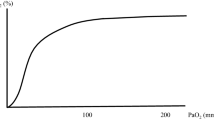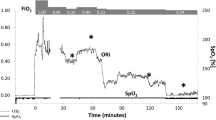Abstract
The oxygen reserve index (ORi™) is a new noninvasive and continuous variable, which represents a moderate hyperoxygenation status, with a unitless scale between 0.00 and 1.00. When percutaneous oxygen saturation (SpO2) exceeds 100%, arterial blood oxygen partial pressure cannot be evaluated without performing arterial blood gas analysis. Because of significant air leakage during rigid bronchoscopy, it is difficult to monitor respiration using capnography, which does not measure end-tidal carbon dioxide (ETCO2) accurately. A 66-year-old man (175 cm, 76.8 kg) with a chief complaint of difficulty in breathing was diagnosed with a thyroid tumor. Computed tomography revealed tracheal stenosis due to direct invasion of the thyroid tumor; therefore, tracheal stenting was planned immediately. After supplying 6 L/min oxygen with a face mask and administering 180 mg of propofol intravenously, the supraglottic airway was intubated. General anesthesia (total intravenous anesthesia) through continuous administration of 6–10 mg/kg/h of propofol and intermittent administration of 50 µg of fentanyl (total 200 µg) preserved spontaneous breathing. During tracheal stent insertion, disconnection between the oxygen supply system and rigid bronchoscopy, and tracheal stent expansion, the ORi tended to decrease before SpO2 decreased. Thus, measuring ORi could prevent hypoxemia during tracheal stent insertion using rigid bronchoscopy.

Similar content being viewed by others
References
Pathak V, Welsby I, Mahmood K, Wahidi M, MacIntyre N, Shofer S. Ventilation and anesthetic approaches for rigid bronchoscopy. Ann Am Thorac Soc. 2014;11:628–34. https://doi.org/10.1513/AnnalsATS.201309-302FR.
Aoyagi T. Pulse oximetry: its invention, theory, and future. J Anesth. 2003;17:259–66. https://doi.org/10.1007/s00540-003-0192-6.
Scheeren TWL, Belda FJ, Perel A. The oxygen reserve index (ORI): a new tool to monitor oxygen therapy. J Clin Monit Comput. 2018;32:379–89. https://doi.org/10.1007/s10877-017-0049-4.
Soehle M, Kuech M, Grube M, Wirz S, Kreuer S, Hoeft A, Bruhn J, Ellerkmann RK. Patient state index vs bispectral index as measures of the electroencephalographic effects of propofol. Br J Anaesth. 2010;105:172–8. https://doi.org/10.1093/bja/aeq155.
Conacher ID. Anaesthesia and tracheobronchial stenting for central airway obstruction in adults. Br J Anaesth. 2003;90:367–74.
Perrin G, Colt HG, Martin C, Mak M-A, Dumon J-F, Gouin F. Safety of interventional rigid bronchoscopy using intravenous anesthesia and spontaneous assisted ventilation. Chest 1992;102:1526–30. https://doi.org/10.1378/chest.102.5.1526.
Szmuk P, Steiner JW, Olomu PN, Ploski RP, Sessler DI, Ezri T. Oxygen reserve index: A novel noninvasive measure of oxygen reserve—a pilot study. Anesthesiology 2016;124:779–84. https://doi.org/10.1097/ALN.0000000000001009.
American Society of Anesthesiologists Task Force on Sedation and Analgesia by Non-Anesthesiologists. Practice guidelines for sedation and analgesia by non-anesthesiologists. Anesthesiology 2002;96:1004–17.
Applegate RL 2nd, Dorotta IL, Wells B, Juma D, Applegate PM. The relationship between oxygen reserve index and arterial partial pressure of oxygen during surgery. Anesth Analg. 2016;123:626–33. https://doi.org/10.1213/ane.0000000000001262.
Vos JJ, Willems CH, van Amsterdam K, van den Berg JP, Spanjersberg R, Struys MMRF, Scheeren TWL. (2018) Oxygen reserve index: validation of a new variable. Anesth Analg. https://doi.org/10.1213/ane.0000000000003706 (Epub ahead of print).
Author information
Authors and Affiliations
Corresponding author
Ethics declarations
Conflict of interest
The authors declare that they have no conflict of interest.
Informed consent
Written informed consent was obtained from the patient.
Rights and permissions
About this article
Cite this article
Niwa, Y., Shiba, J., Fujita, H. et al. Oxygen reserve index (ORi™) contributes to prediction of hypoxemia and patient safety during tracheal stent insertion using rigid bronchoscopy: a case report. J Clin Monit Comput 33, 1011–1014 (2019). https://doi.org/10.1007/s10877-018-0232-2
Received:
Accepted:
Published:
Issue Date:
DOI: https://doi.org/10.1007/s10877-018-0232-2




